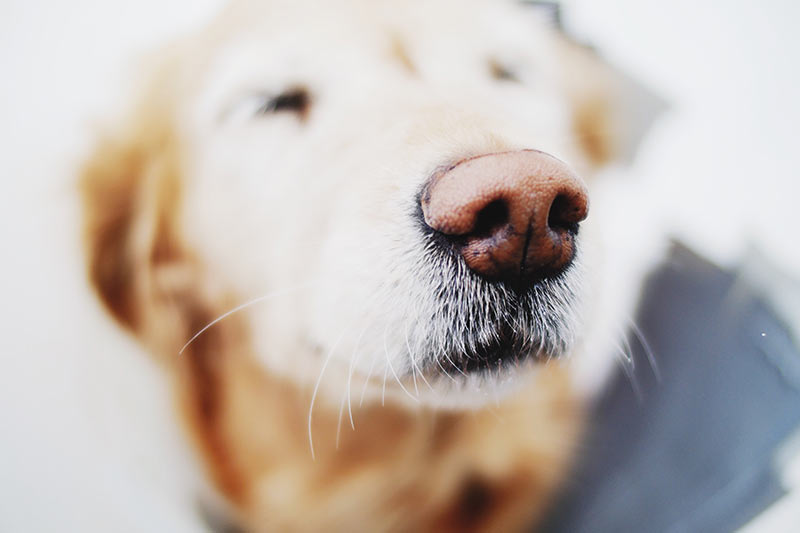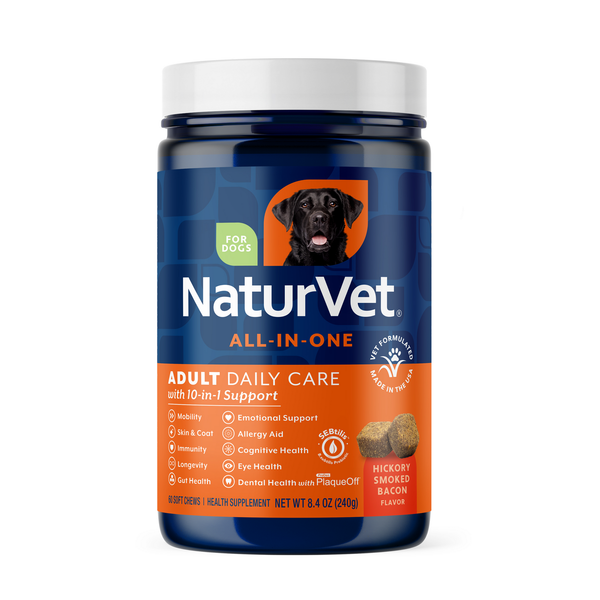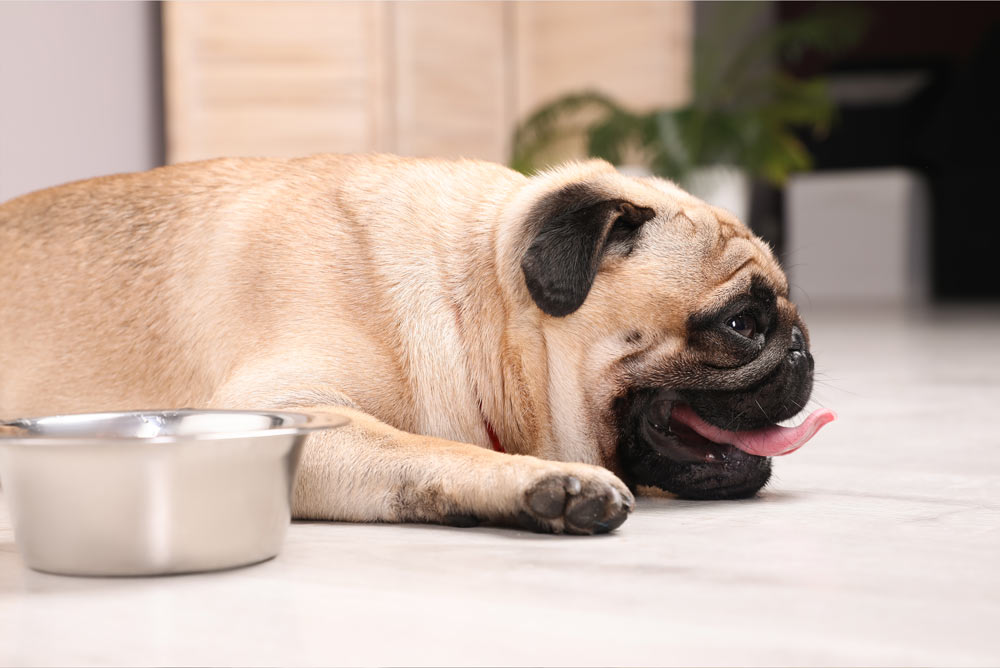Top 5 Signs of Dehydration in Dogs
Written by Chris Vanderhoof, DVM, MPH
Getting out and about during the summer with your dog is enjoyable not just for bonding and relaxation for you, but for your pup too! Most dogs love being outdoors.
But in the hotter months, we always have to be wary and careful of the effects that too much activity in the heat can lead to.
Dehydration is one such effect of playing and exercising too much. And this can happen even faster when it’s hot or humid. In dogs, dehydration may not be very apparent early on, but if left to progress, it can be very serious and even life-threatening.
In this article, you’ll learn what causes dehydration in dogs (including non-heat-related reasons too), the top 5 signs of dehydration in dogs to look for, some tips on how to rehydrate a dog at home, and when to take your pup to the vet.
What Causes Dehydration in Dogs?

The body requires constant, adequate hydration. Whether we’re talking about us or our pets, our bodies are all composed of about 60-70% water. But even with all that water, our bodies can’t tolerate losing very much of it. Even a 5-10% loss can be a big problem and 12% or more hydration loss can actually be life-threatening.
Usually, dehydration occurs from either a lack of water intake, or a loss of it from the body.
A lack of intake may occur because adequate water has not been provided, or a pup’s access to it is restricted. There are also some dogs who do not drink enough on a daily basis and must be encouraged to do so.
Loss of hydration can occur with any kind of fluid loss. This might be from a bout of vomiting or diarrhea. Intestinal parasites and dietary indiscretion are the most common causes of digestive upset in dogs. Very watery diarrhea and protracted vomiting can quickly lead to severe dehydration.
Heat-related illness is also a common cause of dehydration in dogs. Especially at this time of year, warmer weather comes on quickly, with high outdoor temperatures and humidity.
Many dogs are poorly able to adapt especially to quick increases in ambient temperature and may not show signs right away that they’re not coping well with a hot, humid summer day.
Because dogs have a very poor ability to sweat, they can only cool themselves down through panting. While panting does cool the body, it works through evaporative cooling, which removes water from the body and can quickly lead to dehydration.
A third category of cause for dehydration in dogs is related to other diseases a dog may have. Diseases like kidney disease and diabetes, that cause excessive urination, can lead to continuous dehydration, even in dogs that try to keep up as much as possible with water consumption.
How to Tell If a Dog is Dehydrated: The Top 5 Signs to Look For
Catching signs of dehydration in dogs early is important to keep it from progressing. Especially if you’re outside on a warm day, engaged in activities, make sure to regularly check your pup for these signs of concern.
- Dry Nose
- The hairless end of a dog's nose, called the nasal planum, is typically cool and moist. There can be some variability in this from pup to pup, but if your pooch’s nose is usually cool and damp and you find that it is warm and dry, this could be an early sign of dehydration.

- Tacky or Dry Gums
- The gums are a small window into a dog’s state of health. Their color and level of moisture can provide valuable information, which is why checking the gums is part of every veterinarian’s general exam.
The gums are normally a light pink color and moist. You should be able to run your finger over the gums without your finger sticking at all. In a dehydrated dog, gums may be just a little bit sticky or tacky, meaning your finger won’t slide over them as easily. Tacky gums indicate dehydration of at least 5%.
In a more severely dehydrated dog, gums will be drier. This often indicates a more severe level of dehydration that requires immediate veterinary care.
It’s important to be aware that if your pet is excessively drooling or salivating, which can also be seen with dehydration, the gums may be artificially wet and slimy.

- Capillary Refill Time (CRT)
- Checking the capillary refill time, or CRT, is another quick and easy thing to check along with gum moisture and should be normal even in cases of mild to moderate dehydration.
If you press down firmly on one area of your dog’s gums with your finger (usually over the upper canine tooth), you should see the light pink gum color blanch to white briefly. This is because you’re squishing the tiny blood vessels in the gums.
In a normally hydrated dog, the capillaries in the gums will refill almost instantly, with a time of fewer than 2 seconds being normal. In a dog with a CRT of greater than 2 seconds, more severe dehydration is usually present, approaching 10-12% or more

- Prolonged Skin Tent
- A prolonged skin tent goes hand in hand with decreased elasticity of the skin. In normally hydrated dogs, if you lift up the skin, typically over the shoulder blades, it should go immediately back down again.
In a dehydrated dog, the skin’s elasticity will be decreased, leading to “tenting” where the skin remains elevated in a tent-like shape where you pulled it up.
In a minorly dehydrated dog with dehydration up to 5%, skin tenting may not be noticeable. That’s where checking the gums is most useful. If you pull up on the skin and it remains tented for less than 1-2 seconds but returns to normal, this generally equates to at least 5-6% dehydration.
If the skin remains tented for at least 5 seconds but returns to normal, dehydration up to 10% is present. If the tent remains persistent and does not return to normal, dehydration of 10% or greater is present, which is considered life-threatening.

Other Signs:
- Sunken Eyes
- Dull Attitude
- Lethargy
- Labored Breathing
- Excessive Drooling
Why were these all grouped together? It’s because they all support signs of really bad dehydration, requiring immediate veterinary care.
If any of these other signs are present, including the eyes looking like they’re sunken back in the sockets, your dog appears weak and mentally dull, or if your pooch is producing a sticky frothy kind of saliva and is breathing with great effort, severe dehydration is present, likely exceeding 10-12%.
These signs are indicative of life-threatening dehydration or heat-related illness. Coupled with them, you are likely to see extended skin tenting, delayed CRT, and dry gums
How to Rehydrate a Dog at Home

If your pup is showing signs of mild dehydration, is not in distress, and has no active, continuing fluid losses (like vomiting or diarrhea), some TLC at home may be okay.
Especially if it’s hot outside, getting your pup indoors with cool air, plenty of cold water, and some rest can get her feeling better.
If your pup is extremely thirsty, avoid letting him chug a whole lot of water at once. This can sometimes lead to vomiting the water back up, which no one wants, especially your dog. Offer water in smaller quantities of a couple of cups at a time, refilling periodically, so your pup has a chance to let some of the water settle before getting more.
Avoid the temptation to give your dog any energy drinks containing sugar. Also remember that some energy drinks, while packed with electrolytes, may also contain caffeine, which causes toxicity concerns of its own in dogs.
While small amounts of an oral electrolyte solution may be okay, especially when added to water, they were not designed for dogs, and you should be thinking about visiting your veterinarian if you are concerned about electrolyte loss and worsening dehydration.
Dog Dehydration Treatment: What Does a Vet Check for and Do?
If your pooch is showing signs of moderate dehydration or worse, or even if you’re not quite sure how dehydrated she may be, it is always better to seek veterinary care. This is especially the case if it’s really hot out where heat-related illness might be a concern, or if there are ongoing losses, like vomiting or diarrhea.
At a veterinary hospital, your pup’s doc will first examine him, evaluating the same signs you’ve learned about in this article, as well as other parameters. Heart rate and pulses can also be very important indicators of how serious dehydration is.
The severity of dehydration can also be evaluated with lab work, which can check for electrolyte imbalances and the presence of underlying diseases.

Veterinarians primarily address dehydration in a more effective manner by administering a balanced electrolyte solution either under the skin, or in a vein.
Subcutaneous fluids administration, where the contents of an IV bag are delivered by a needle under your dog’s skin in the area of the shoulder blades, is a fast and uncomplicated way to deliver fluids directly into the body. Unlike people, dogs have a lot of space under their skin where the fluids can be delivered, and they will typically then absorb those fluids over the course of the next 1-2 hours.
Subcutaneous fluids are usually reserved for uncomplicated cases of dehydration with a mild associated illness.
In more severe cases of dehydration, especially if a dog is very visibly ill, fluids are given intravenously. For this to happen, an IV catheter needs to be placed. Administering fluids this way provides the most rapid delivery to the body, correcting dehydration, and electrolyte imbalances the fastest.
With intravenous fluids, there is usually enough concern present to keep your dog in the hospital for monitoring and possibly other medications if indicated.
Conclusion
While dehydration can be concerning, does this mean you shouldn’t get outdoors and play with your pup?
Absolutely not!
The most important thing to remember about dehydration is to always be on the lookout for it if your pup is at risk and to recognize early signs of dehydration in dogs before they worsen.
When playing or exercising outside this summer, utilize time in the early morning or late evening when it’s cooler, and always give your pup a break every 15-20 minutes for some water and a quick health check using the parameters you’ve learned.
When traveling, always have a source of fresh, bottled water and a bowl handy.
While hospitalizing a dog is sometimes necessary for dehydration, prevention, and early detection with these simple tips can make all the difference for your pup and help you to avoid a costly and stressful hospital visit.

JOIN OUR PACK
Follow us @NaturVet on social media to fill us in on any tips we might have missed. And, check out the rest of NaturVet.com. We’ll keep you up to date on all our latest pet resources, supplements, tips and tricks, and more – everything you need to be the best pet parent possible.























